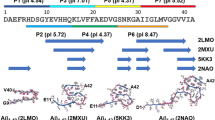Abstract
The potential of the nitro compounds of the azoloazine class as regulators of aggregation of natural self-associating peptides was demonstrated by the example of fragments of the Alzheimer β-amyloid peptide and the melittin cytolytic peptide from bee venom. Depending on the type of an azoloazine derivative, association of a peptide into insoluble aggregates either occurred or was suppressed up to the peptide aggregates dissolution. The sites and stoichiometry of the azoloazine binding to the examined peptides are determined in the associates. These effects were explained by a unique ability of the azoloazine nitro derivatives to dissociate in aqueous solutions with the formation of a stable aromatic anion with electrostatic affinity to basic amino acid residues of the peptide molecules. This property of nitroazoloazines was used for a test of their ability to regulate the aggregation processes. Therefore, the nitro derivatives of azoloazines are promising inducers or inhibitors of the aggregation of the Alzheimer β-amyloid peptide and, possibly, other peptides which can form amyloid deposits.
Similar content being viewed by others
Change history
17 October 2019
erratum
References
Bello, J., Bello, H.R., and Granado, E., Biochemistry, 1982, vol. 21, pp. 461–465.
Quay, S.C. and Condie, C.C., Biochemistry, 1983, vol. 22, pp. 695–700.
Shai, Y., Biopolymers, 2002, vol. 66, pp. 236–248.
Bechinger, B., J. Membr. Biol., 1997, vol. 156, pp. 197–211.
Wu, W.H., Sun, X., Yu, Y.P., Hu, J., Zhao, L., Liu, Q., Zhao, Y.F., and Li, Y.M., Biochem. Biophys. Res. Commun., 2008, vol. 373, no. 2, pp. 315–318.
Stsiapura, V., Sukhanova, A., Baranov, A., Artemyev, M., Kulakovich, O., Oleinikov, V., Pluot, M., Cohen, J.H.M., and Nabiev, I, Nanotecnology, 2006, vol. 17, no. 2, pp. 581–587.
Melnikau, D., Savateeva, D., Lesnyak, V., Gaponik, N., Fernandez, Y.N., Vasilevskiy, M.I., Costa, M.F., Mochalov, K.E., Oleinikov, V., and Rakovich, Y.P., Nanoscale, 2013, vol. 5, no. 19, pp. 9317–9323.
Murphy, M.P. and LeVine, H., 3rd, J. Alzheimers Dis., 2010, vol. 19, no. 1, p. 311.
Perez, M., Cuadros, R., Benitez, M.J., and Jimenez, J.S., J. Alzheimers Dis., 2004, vol. 6, no. 5, pp. 461–467.
Rusinov, V.L., Petrov, A.Yu., and Postovskii, I.Ya., Khim. Geterotsikl. Soed., 1980, pp. 1283–1285.
Shestakova, T.S., Khalymbadzha, I.A., Deev, S.L., El’tsov, O.S., Rusinov, V.L., Shenkarev, Z.O., Arsen’ev, A.S., and Chupakhin, O.N., Izv. Akad. Nauk, Ser. Khim., 2011, pp. 714–717.
Chupakhin, O.N., Rusinov, V.L., Ulomskii, E.N., Charushin, V.N, Petrov, A.Yu., and Kiselev, O.I., RF Patent no. 2330036, 2008.
Chupakhin, O.N., Rusinov, V.L., Ulomskii, E.N., Charushin, V.N., Petrov, A.Yu., and Kiselev, O.I., RF Patent no. 2294936, 2007.
Koz’min, Yu.P., Manoilov, A.V., Serebryakova, M.V., and Mirgorodskaya, O.A., Russ. J. Bioorg. Chem., 2011, vol. 37, no. 6, pp. 719–731.
Kozmin, Yu.P., Manoilov, A.V., Serebryakova, M.V., and Mirgorodskaya, O.A., Russ. J. Bioorg. Chem., vol. 37, no. 6, pp. 719–731.
Toropygin, I.Y., Kugaevskaya, E.V., Mirgorodskaya, O.A., Elisseeva, Y.E., Kozmin, Y.P., Popov, I.A., Nikolaev, E.N., Makarov, A.A., and Kozin, S.A., Rapid Commun. Mass Spectrom., 2008, vol. 22, pp. 231–239.
Esler, W.P., Stimson, E.R., Ghilardi, J.R., Lu, Y.A., Felix, AM., Vinters, H.V., Mantyh, P.W., Lee, J.P., and Maggio, J.E., Biochemistry, 1996, vol. 35, pp. 13914–13921.
Tjernberg, L.O., Callaway, D.J., Tjernberg, A., Hahne, S., Lilliehook, C., Terenius, L., Thyberg, J., and Nordstedt, C., J. Biol. Chem., 1999, vol. 274, pp. 12619–12625.
Hilbich, C., Kisterswoike, B., Reed, J., Masters, C.L., and Beyreuther, K., J. Mol. Biol., 1992, vol. 228, pp. 460–473.
De Groot, N.S., Aviles, F.X., Vendrell, J., and Ventura, S., FEBS J., 2006, vol. 273, pp. 658–668.
Gazit, E., FASEB J., 2002, vol. 16, pp. 77–83.
Cukalevski, R., Boland, B., Frohm, B., Thulin, E., Walsh, D., and Linse, S., ACS Chem. Neurosci., 2012, vol. 3, no. 12, pp. 1008–1016.
Armstrong, A.H., Chen, J., McKoy, A.F., and Hecht, M.H., Biochemistry, 2011, vol. 50, pp. 4058–4067.
Creighton, T.E., Proteins: Structures and Molecular Properties, New York: Freeman, 2nd ed., pp. 4, 256.
Funke, S.A. and Willbold, D., Current Pharmaceutical Design, 2012, vol. 18, pp. 755–767.
Author information
Authors and Affiliations
Corresponding author
Rights and permissions
About this article
Cite this article
Mirgorodskaya, O.A., Kozmin, Y.P., Protasov, A.D. et al. Regulation of Aggregation of Self-Associated Peptides, Including N-Terminal Fragments of the Alzheimer’s β-Amyloid Peptide, by Nitro Derivatives of Azoloazine. Russ J Bioorg Chem 44, 665–675 (2018). https://doi.org/10.1134/S1068162019010096
Received:
Accepted:
Published:
Issue Date:
DOI: https://doi.org/10.1134/S1068162019010096




